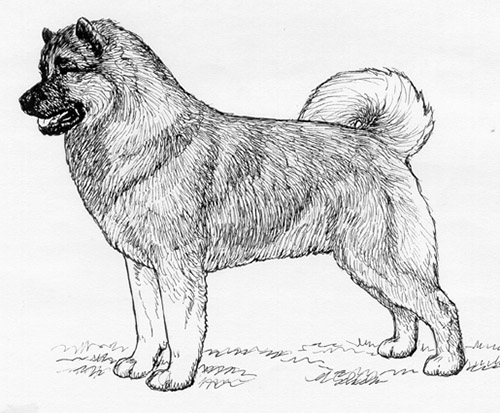Eurasier
Northern Breed Group
The goals and purposes of this breed standard include: to furnish guidelines for breeders who wish to maintain the quality of their breed and to improve it; to advance this breed to a state of similarity throughout the world; and to act as a guide for judges.
Breeders and judges have the responsibility to avoid any conditions or exaggerations that are detrimental to the health, welfare, essence and soundness of this breed, and must take the responsibility to see that these are not perpetuated.
Any departure from the following should be considered a fault, and the seriousness with which the fault should be regarded should be in exact proportion to its degree and its effect upon the health and welfare of the dog and on the dog’s ability to perform its traditional work.
History
The Eurasian is a fairly new breed of dog that was created by crossing a Chow Chow and a Wolfspitz. At first they were called a Wolf-Chow, but after the addition of some Samoyed blood, the name was changed to Eurasian.
The Eurasian was recognized by the United Kennel Club January 1, 1996.
General Appearance
The Eurasian is a nicely balanced, well constructed, medium sized dog of Spitz type, with prick ears and moderate length of coat that comes in varying colors. Males should be masculine, and females feminine.
Characteristics
The Eurasian is a dog that was developed to be a family companion. It has no hunting instinct. The breed is self assured, calm and even tempered. It is very attached to its family but reserved, though never aggressive, towards strangers.
Head
Viewed from either above or in profile, the head is wedge shaped, with the skull and muzzle being nearly equal in length and parallel to one another.
SKULL
The skull is not too broad. The forehead is flat and there is a distinct frontal furrow and a well-defined occiput. The stop is barely defined.
MUZZLE
The muzzle is tapered, but not pointed. The nasal bridge is straight. The lips are tight and have black pigmentation.
TEETH
The Eurasian has a complete set of evenly spaced, white teeth meeting in a scissors or level bite.
Serious Faults: Undershot or overshot bite.
NOSE
Medium size, with black pigment.
EYES
The eyes are medium size, neither sunken nor protruding. They are dark in color and set slightly obliquely. The lids are tight, and have black pigmentation.
EARS
The prick ears are medium in size, triangular in shape, with slightly rounded tips. The distance between the ears is approximately the same as the width of the ear at the base. The tips of the ears and the center of the stop should form a nearly equilateral triangle.
Disqualifications: Semi prick or hanging ears.
Neck
The neck is medium length, well muscled, and flows smoothly into the body. There is no dewlap.
Forequarters
The shoulder blade and upper arm are well muscled, nearly equal in length and form a moderate angle.
FORELEG
Straight and parallel, with a medium length, well-muscled forearm. The elbows are close to the body and the pasterns slightly inclined.
Body
Not too short in back. The chest is oval shaped and deep to the elbows, with a moderately developed forechest. The long sternum reaches far back. The withers are pronounced, and the back is firm and muscular. The loin is of good length and broad. The croup is straight, broad and strong. There is a slight tuck-up.
Hindquarters
The hindquarters are moderately angulated.
HIND LEGS
Straight and parallel when viewed from behind. The upper and lower thighs are muscular and approximately equal in length. The stifle is solid and not too straight. The rear pasterns are of good length.
Feet
Oval and tight, with moderately arched toes. The pads are firm and well cushioned. They are black in color, and thick hair grows between them.
Tail
Set on high, thick at the base, and tapering towards the tip, the tail is long enough to reach to the hock when it is hanging down. The tail is carried lying forward over the back, bent slightly sideways, or rolled up. It is covered with bushy hair.
Coat
Double, with a medium length, loose outer coat and a thick undercoat. The hair on the muzzle, face, ears and front of legs is short. The tail, back of front legs and back of thighs are covered with long, thick furnishings. The coat on the neck is only slightly longer than on the body, not forming a mane.
Color
All colors and combinations of colors are permitted, with the exception of pure white, white patches, or liver.
Height and Weight
The ideal height for males is 22 inches, for females it is 20.5 inches. There is a tolerance of 1.5 inches in either direction. Ideal weight for a 22-inch male is 57 pounds; for a 20.5-inch female it is 48 pounds.
Gait
Ground covering, with plenty of reach and drive.
Disqualifications
(A dog with a Disqualification must not be considered for placement in a conformation event, and must be reported to UKC.)
Unilateral or bilateral cryptorchid.
Viciousness or extreme shyness.
Albinism.
Semi prick or hanging ears.

Looking for a Dog?
Find a dog that will fit your family.
Note: The breeders on this list are not endorsed by UKC.
©Copyright 1996, United Kennel Club
